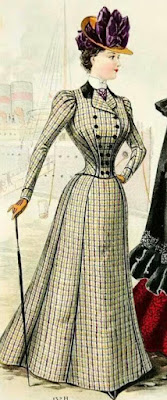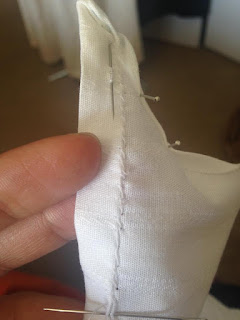1830's Lapis Lazuli Gown
While I'm a few years behind the Gigot craze that rocked costuming community back in 2019, I finally managed to make an 1830's day gown of my own. Everything about the gigantic sleeves, the bell-shaped skirts, and the ornate hairstyles, lured me to this awkward and fascinating era of fashion - I'm all about it!
Materials:
7 yards of printed cotton fabric
2 yards of tulle (for sleeve enhancers)*
3 yards of scrap fabric (for sleeve enhancers)*
3 yards of muslin to line the bodice (the pattern calls for 7 to line the entire gown, but that can be left entirely up to the wearer in my opinion)
2 packs of piping trim
corset bones to stabilize the front and back of bodice
Small Hook & Eye closures
Pattern-TV455 from Truly Victorian
After preparing the pattern and cutting out the fabric, it was pretty easy to put the mockup together for the bodice. However, I failed to realize that the bodice actually closes up in the back rather than in the front. But, I figured that's okay: just go with it! With some outside consulting from Mem Barnett from Star & Scissor, I would design the skirt the same way I would with a 1780's round gown; tying the waistband to the back like an apron, in order to get in/out easier.
To make the sleeve enhancers which puff up the sleeves to maintain their shape, I used the always helpful American Duchess tutorial for reference. I found that using tulle was a good and affordable substitute for goose-down as it is much lighter and squishable.
The challenging part of making this gown was how to add on the front closures with hook & eyes without the risk of overlapping. Typically with most of my historical costumes, I am accustomed to pinning or buttoning everything in place (with usually an overlap). This being my first 1830's gown, and no real solution on how to avoid overlapping or gaps in the front, this left me perplexed but willing to try my hand at it anyway. Sewing the hook and eyes VERY securely between the fabric layers (muslin and outer fabric) seemed to do the trick. But if there's anyone who knows any tricks to best improve this technique, please let me know.
I really had a lot of fun experimenting with this pattern and making the gown. It was pretty quick to put together. While not pictured here, I did purchase a chorded petticoat from an Etsy seller, and used a smaller hip pad and 18th century flounced petticoats to fluff up the skirt.








.jpg)


Great work.
ReplyDelete